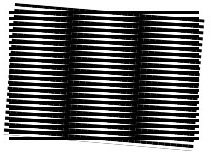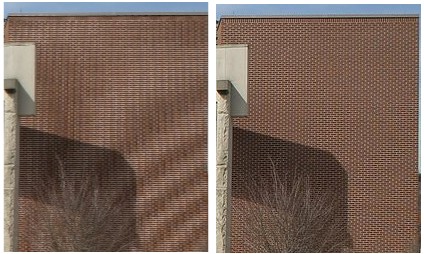Physicist: There are two major effects that generate waves in pictures. The first is called “aliasing”, and it’s caused by “under-sampling”. It shows up every now and again when you’re using a digital camera, or when you’re trying to express a picture that contains a regular pattern using too few pixels. The frequency of the pattern is accidentally read as a different frequency. The second effect is called a Moiré pattern, and it shows up when the camera’s CCD and what the camera is pointed at disagree about what’s horizontal and vertical. It’s a problem when the lines in question are around 1 or 2 pixels thick. Technically, in the context of digital cameras, this is just aliasing again.
Normally aliasing is a problem in analog to digital conversion of sound, but it comes up in a number of places. There’s a theorem called “Nyquist’s theorem” that states that if the highest frequency in a signal or pattern is X, then you need to sample at a frequency of at least 2X or you’ll get aliasing. In the case of pictures, the smaller the pattern, the higher its “frequency”, and the higher the pixel count the higher the “sampling frequency”.

Aliasing: All three of these waves have the exact same value at 0, 2, 4, etc. so if you're sampling every 2, then they all look the same to you.
For example, most people can hear up to about 22,000 Hz (young people can hear a little higher), so digital recording equipment has to sample sound at least 44,000 times per second (44,000 Hz). In practice most equipment samples even more. In this case aliasing causes stray sounds that should be above human hearing to show up in the recording. Very off-putting.
So, if you have a regular pattern of some kind, like bricks, and you take a picture of it, then in order to avoid weird looking waves, you need at least two pixels per brick.
In the picture above the “high-frequency bricks” are aliased and appear to have “low-frequency ripples”. The effect goes away when you use a zoom lens or a higher resolution, because the sampling frequency increases.
It’s a lot more common to see aliasing show up in digital sound recordings and in video. The standard 24 frames per second (a sampling frequency of 24 Hz) means that things that repeat faster than 12 times per second will be aliased. The most jarring example of video aliasing is the “wagon-wheel effect”. A spinning object on film can appear to be turning at the wrong speed, turning backwards, or even sitting still. There are some dramatic examples: here and here.
The easiest way to completely avoid aliasing and Moire patterns is to use analog cameras and actual film. That said, the digital cameras today have such high resolutions that aliasing is pretty unusual.
Answer gravy: So, why do you need to sample at double the frequency, and not just at the frequency?
A wave can be described as , where A is the amplitude (size), f is the frequency (how fast it oscillates), and ϕ is the phase (slides the whole thing back and forth). If all you can do is sample the wave, at times
(t=nT), then you get a string of values
. By definition, the sampling frequency, fs, is 1/T.
So, .
But check it: you can add a multiple of 2π inside of sine whenever you want and it doesn’t change anything (sine is “2π periodic“). So:
This means that . That is, waves with frequency f, f+fs, f+2fs, etc. will all give you exactly the same set of measurements (xn). You cannot tell them apart.
But more than that:
This type of aliasing is responsible for wheels appearing to spin backward on film.
The “π-ϕ” is different from “ϕ”, however this new phase doesn’t impact the frequency (frequency is what you see and hear).
So, as well as
. For succinctness:
.

Because of the layout of frequencies that all appear the same (red lines) you can only trust frequencies below half of the sampling frequency, fs.
So check it! If you have some way to guarantee that the frequency you’re measuring is below (using filters or something), then what you see between 0 and
will be correct. Otherwise, what you see between 0 and
may be an alias of a different, higher frequency.
Clearly, most signals aren’t a single frequency the way a sine wave is. But that doesn’t really matter, since you can write a signal out as a bunch of sine waves added together, and the same math applies to each of those.









3 Responses to Q: Why is it that photographs of wire mesh things, like window screens and grates, have waves in them?